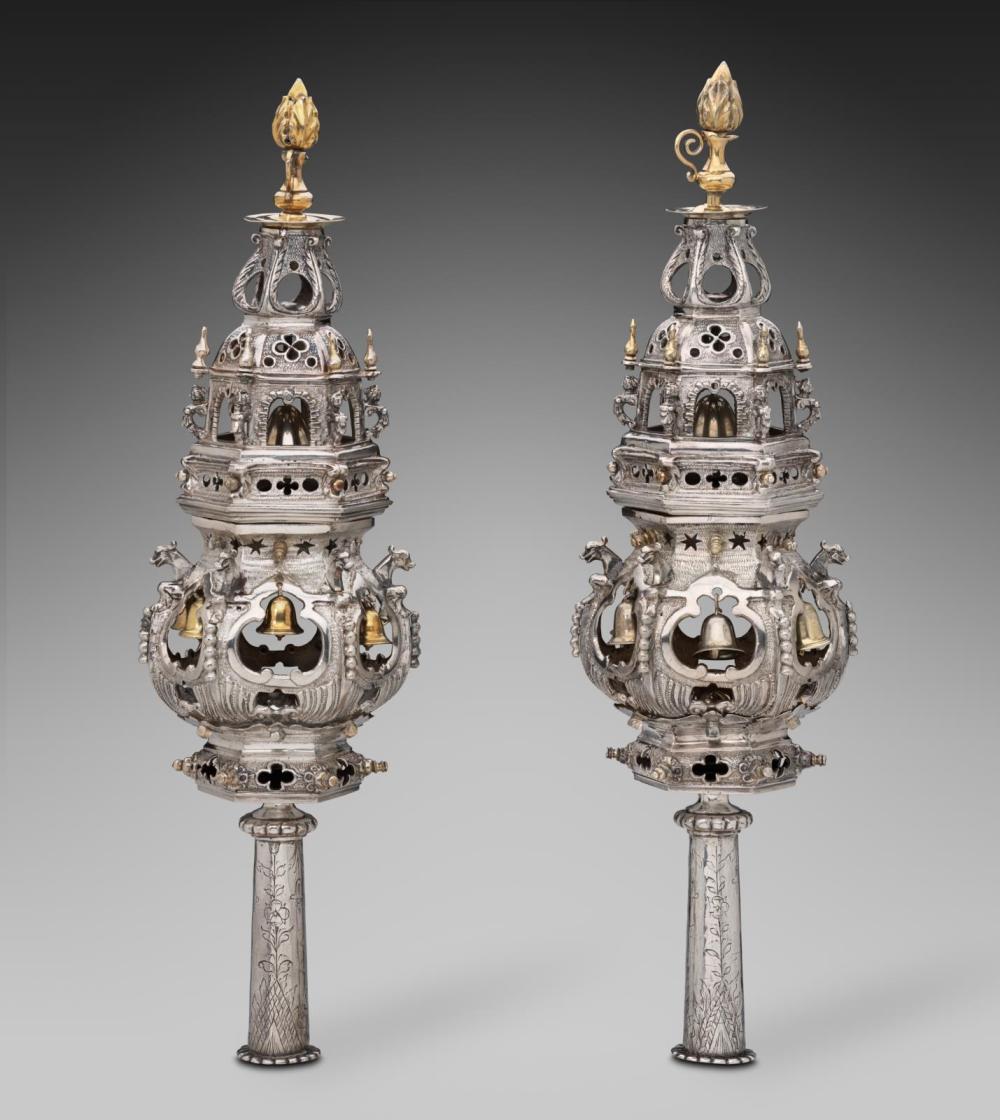Advanced Search 

Pair of Torah finials
Dutch (Rotterdam)
1649
Medium/Technique
Silver, parcel gilt
Dimensions
Height: 42.5 cm (16 3/4 in.)
Credit Line
Museum purchase with funds donated by Rose-Marie and Eijk van Otterloo in support of the Center for Netherlandish Art
Accession Number2021.60.1-2
NOT ON VIEW
ClassificationsRitual objects
Torah finials are silver ornaments that decorate the top of Torah scrolls. This pair is earliestknown surviving example from the Netherlands, and the earliest traceable pair showing the three-tiered, hexagonal form that became highly influential over the next two hundred years as the main Dutch type, spreading to the Sephardic congregations of London and Hamburg.
While Amsterdam is recognized as a center of Jewish culture, these finials linked to Rotterdam present the story of Jews in other cities. Rotterdam had a Jewish presence as early as 1610, and a second wave of Portuguese Jews arrived in 1647, after the city government granted new rights, most importantly the opening of a synagogue. That the date 1649 indicated marked on this pair of finials is a mere two years later is unlikely to be coincidental, and rather suggests that they were made for Rotterdam’s recently inaugurated synagogue.
Later in time, and possibly with Dutch Jewish immigrants, the Torah finials arrived in Central Synagogue in Great Portland Street, London, where they were kept until the MFA acquired them in 2020. Due to the loss of the synagogue's archival documents during the Blitz, it is uncertain when these finials arrived in London..
While Amsterdam is recognized as a center of Jewish culture, these finials linked to Rotterdam present the story of Jews in other cities. Rotterdam had a Jewish presence as early as 1610, and a second wave of Portuguese Jews arrived in 1647, after the city government granted new rights, most importantly the opening of a synagogue. That the date 1649 indicated marked on this pair of finials is a mere two years later is unlikely to be coincidental, and rather suggests that they were made for Rotterdam’s recently inaugurated synagogue.
Later in time, and possibly with Dutch Jewish immigrants, the Torah finials arrived in Central Synagogue in Great Portland Street, London, where they were kept until the MFA acquired them in 2020. Due to the loss of the synagogue's archival documents during the Blitz, it is uncertain when these finials arrived in London..
DescriptionGlobular tower form, the staves engraved with blooming plants emerging from patterned bases, the lower bodies with monster-headed brackets on matted grounds, enclosing auricular openings hung with bells, the second tier with masonry arches between female-headed scroll brackets topped by gilt finials, pierced "domes" and openwork bud-form top sections, the finials formed as buds emerging from lavers and basins, probably of a later date
Marks
On bases of main section with city mark and date letter E mark
ProvenanceProbably by about 1900, United Synagogue, London [see note]; December 17, 2020, sale (consigned by the United Synagogue), Sotheby’s, New York, lot 107, to the MFA. (Accession Date: February 24, 2021)
NOTES:
[1] The United Synagogue was formed in 1870 when five London synagogues (including the Central Synagogue) joined together. According to a representative of the United Synagogue, the silver was in the collection of the Central Synagogue or another branch of the United Synagogue for decades and certainly prior to the bombing of Central Synagogue in 1941. One of these two finials incorporates bells made by the London silversmith Abraham Benelisha dating to around 1900, suggesting they were in London by that time.
NOTES:
[1] The United Synagogue was formed in 1870 when five London synagogues (including the Central Synagogue) joined together. According to a representative of the United Synagogue, the silver was in the collection of the Central Synagogue or another branch of the United Synagogue for decades and certainly prior to the bombing of Central Synagogue in 1941. One of these two finials incorporates bells made by the London silversmith Abraham Benelisha dating to around 1900, suggesting they were in London by that time.
